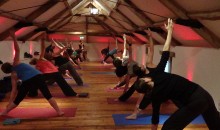Tips for energising Spring Yoga
February 17, 2011
 Being sister sciences, Ayurveda and Yoga developed together and repeatedly influenced each other throughout history. The popularity of Yoga in this country has been growing steadily since Swami Vivekananda first brought the ideas of Yoga to the West in 1893. In contrast, Ayurveda, was largely left behind in India and most western books on Yoga mention little on Ayurveda. Thankfully, Ayurveda is now catching up with Yoga’s popularity with key books on the subject now published (see Reading list).
Being sister sciences, Ayurveda and Yoga developed together and repeatedly influenced each other throughout history. The popularity of Yoga in this country has been growing steadily since Swami Vivekananda first brought the ideas of Yoga to the West in 1893. In contrast, Ayurveda, was largely left behind in India and most western books on Yoga mention little on Ayurveda. Thankfully, Ayurveda is now catching up with Yoga’s popularity with key books on the subject now published (see Reading list).
Yogis need to consider not only their Ayurvedic Doshic constitutions/imbalance but also age, season and times of day for an Ayurvedic yoga practice. For example, during sunrise and sunset, vata is most stimulated and so calming, grounding asanas are best at these times. After 6:00am is Kapha time and a more stimulating practice is better. It is important to note that whilst some asanas are better for some types than others, we need to do all the major asanas for full health, just as we need all 6 Ayurvedic tastes in a meal. A full practice should include sitting, standing, lying, expansive, contractive, ascending, descending movements. Mukunda Stiles also reminds us, “Regardless of which doshas is imbalanced, balancing Vata and returning the pranas to their home region and function can rectify all other doshas… all students need to have a Sadhana that begins and concludes with Vata balancing.”
Some general tips for reducing sluggish Kapha dosha (eg: weight gain, sluggishness and depression or Winter ‘blues’) at this time of year to aid your detox:
- Practice at a vigorous pace and intensity but do not overstrain the heart at the beginning of taking up yoga.
- Practice in a warm space
- Use a strong forceful breath during practice, pausing for a moment between inhalations and exhalations
- When you feel ready to release the pose, take one more breath- challenge yourself
- Keep your chest and shoulders open and lifted as you practice (a Kapha site in the body where mucus can accumulate).
- Keep your gaze looking up and feel a sense of lightness in your poses.
- Keep moving. Have shorter resting periods between poses.
Some specific postures recommended for Spring:
- Fast sun salutes and other Vinyasa flow sequences are excellent for Kapha imbalance as they are heating, aerobic and open the chest. Sun salutations are excellent for anyone during the Kapha hours of the day (6am-10am). People of Kapha nature should do the most repetitions and they should be performed with greater speed
- Lion pose or sitting poses with warming pranayama (right nostril or solar breath) to prevent daydreaming
- Warrior poses which open the chest, and Ardha Chandrasana (Half Moon)
- Down dog, Up dog (and all poses which open the chest reduce congestion and aid breathing)
- Inverted balancing poses like handstand, peacock
- Headstand and Shoulderstand, bridge (excellent!), plough (excellent for opening lungs) and their variations
- All backbends, especially camel pose and bow pose (stimulates digestion). Less forward bending as it contracts the chest.
- A short savasana
The following books are recommended for more detail on tailoring yoga according to Ayurvedic wisdom:
1. Ayurvedic Yoga Therapy, Mukunda Stiles (2007)
2. Yoga and Ayurveda, D Frawley (1999)
3. Yoga for Your Type: An Ayurvedic Approach to Your Asana Practice, D Frawley, S Kozak (2001)
We will also explore Kapha balancing yoga in the Spring Ayurveda and Yoga Detox weekend, March 2011.
